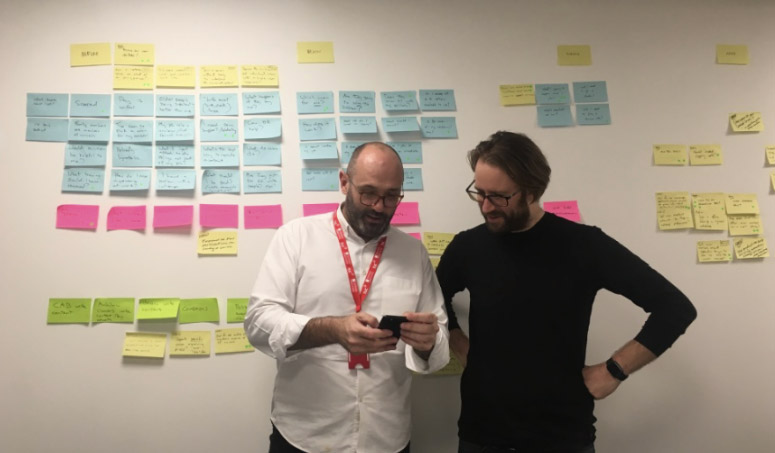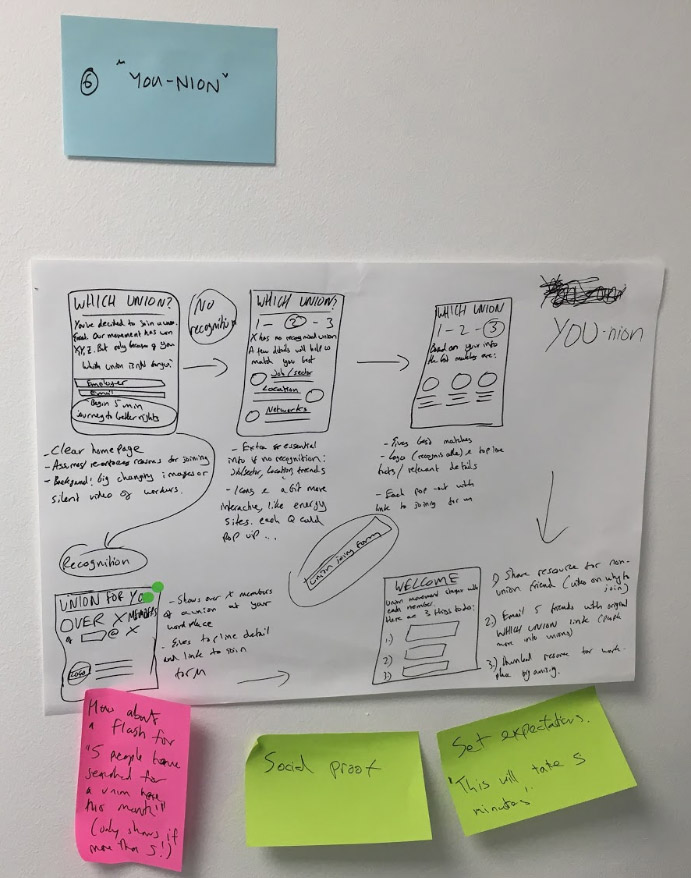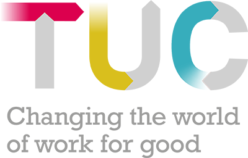A key function for the TUC online is to signpost people to trade unions. Thousands use the unionfinder tool on TUC sites every month, but it is under-performing, with difficulties in giving people authoritative results, and a user journey that is losing some people along the way. We ran the TUC’s first design sprint around this issue, looking at the challenge of how people find the right union and how to make it easy for them to join it.
Who took part?
- John Wood, TUC Digital Manager
- Jay Sreedharan, TUC Website Editor
- Carl Roper, TUC National Organiser
- Donnacha DeLong, NUJ
- Craig Barker, CWU
- John Stammers, GMB
- Richard Pope, Freelance Digital Product Designer
- Facilitator: Sam Jeffers, The Shop
We took over a room at Congress House for a week to go through a series of exercises to help us work out a specific challenge, develop ideas to solve it, build a prototype and start to test it with some real potential users.
Here’s what we did, day-by-day.
Before the sprint:
- Recruited the team
- Decided roughly what we wanted to think about, namely, seeing if we could improve the way the “Find a Union” tool worked ahead of next year’s heartunions week.
- Set some homework.
The homework:
We asked everyone to do some user research to think about the circumstances and views of younger people who aren’t members of a union. We wanted to understand more about:
- What work they do and what does a typical day look like?
- What types of problem do they encounter at work?
- How do they seek advice about work problems? Who do they seek it from?
- How do they think their employer treats them?
- What do they think of unions?
- How would they find and join a union?
Day 1: Wednesday 16th December
We convened in a meeting room at Congress House to start our sprint. After introductions (at least half the team hadn’t met or worked together before) and talking through the work we’d be doing, we started thinking about what an ambitious future goals would be.
After 20 minutes discussion, we settled on:
In five years:Everyone who starts work knows of the existence of unions and people have a clear route into one Unions will be present in the workplace Unions are seen as a force for real change |
We also discussed the things that we wanted to make sure we considered as we started to design potential solutions.
We asked, how might…
- We design to match normal user expectations?
- Unions help one another?
- We use data that’s accurate?
- We talk about the wider value unions create (not just the personal benefit of membership)?
- We make things people will share to recruit others?
- We compete in the search for solutions to problems at work (for example vs. solicitors willing to pay for expensive Google keywords)?
The rest of the day was spent building and improving a map of the challenge. We split this into three streams and four phases to produce a grid:
| Before people know a union is right for them | Beginning – thinking about joining a union | During – the act of joining a union | After – what happens after joining | |
| Users – what are they thinking feeling and doing? | ||||
| Interactions – what are users interacting with? | ||||
| Behind the scenes – what’s making it all happen? |
We then filled this out based on the user research we’d all done before the session, the TUC’s experience of building and rebuilding tools like the Union Finder and our collective experience of working in and around unions in recent years.
If you’re doing another digital project for unions, or are exploring technology for workers, here are the user needs that our research generated.
While we were mapping, the team took notes of any ideas for the remainder of the sprint. Some of these were simple practical things, others more speculative, pointing to bigger, unknown opportunities for union technology such as:
- How might we create more centralised sources of data?
- How might we have union members collect and share data about rates of pay?
- How might we help people be a union member when doing casual work across sectors?
- How might we use wikis to have unions co-create help guides for dealing with problems at work?
The result was a wall full of questions and opportunities, which we then further improved by interviewing one another about our own professional experiences – for example of how specific unions deal with queries from the common (e.g. “I have a problem at work and need help today” and “how do we organise in our workplace?”) to the complex (e.g. “two unions are recognised by an employer, in different locations”, or “as a union rep for union X in workplace Y, I have to be represented by a different union Z”).

These really helped our collective understanding of the scale and complexity of the challenge at hand, but also allowed us to focus in on what we felt we could design for during the sprint.
Lastly on day 1, we decided where we wanted to focus – how could we make finding and joining a union as easy as possible?
The boxes with orange stickers are the areas we in which wanted to challenge ourselves:

Other interesting challenges we rejected for the sprint (but would be useful in the future) were:
- How can we help people get better information about a workplace issue?
- How can we help them evaluate the various places (friends, family, colleagues, solicitors, the Citizen’s Advice Bureau etc) they’d get information about a workplace issue?
- How can we help reps organise the workplace?
- How can we help people move between unions?
- How can we redesign some aspects of joining a union? E.g. How are you welcomed? How do you choose your communication preferences? How are expectations for your future involvement created?
Day 2: Thursday 15th December
This, as the football pundits say, was a day of two halves.
In the morning, we spent a couple of hours looking at digital experiences organisations have created. In particular, we looked at energy comparison and switching, and charity donations, taking “how might we” notes as we went.
There were some really interesting design choices, particularly in the switching and payment flows, that we thought could influence the way we helped people join a union:
- Increased transparency about the process and the way we set user’s expectations
- Making sure it worked equally well in as many contexts as possible – mobile, desktop
- Removing as many steps as possible
- Reducing the load on the user – asking for less information, working out how to not ask for more complex information (e.g. meter readings) early on (or preferably, at all).
- Taking on work for the user in order to make their experience better
- Making the emotional, as well as the rational case
Three examples stood out:
- MoneySupermarket – where large, obviously well-tested design made switching energy provider straightforward.
- Bulb Energy – who clearly do much of the hard work in the background for users, and set expectations around the timings for switching provider very transparent.
- South London Cares – who make it easy and personal to volunteer for their charity, with quick, responsive supporter care.
In the afternoon, we put everything we’d learned about the challenge so far into practice.
For this, each team member works solo to build on everything we’ve brought into the room over the previous 10 or so hours. All of the notes, ideas and expertise.
A few observations:
- Though not everyone in the room had a background in designing digital products, everyone knew well enough what they had to do (particularly interesting – everybody designed mobile-first solutions with no prompts).
- All of the solutions were dramatically simpler than any existing find/join a union workflows. The team recognised that the needs of the user should trump the specific rules of different unions.
Here are a few of the sketches proposed:


Things to note:
- Rough and ready is fine. You don’t need to be a great artist to communicate your ideas.
- Every idea contributed something to the final prototype.
- The goal is to keep augmenting and refining our thinking.
Day 3: Friday 16th December
Friday was the day when we’d make some decisions about what to prototype.
In the morning, we spent a couple of hours reading our way through the sketches and highlighting the ideas we felt met our goals. Lots of sticky dots made for a very democratic process – showing us even the smallest things that the group felt might contribute to a better final prototype.
We then started to focus in on the ideas we felt moved things forward furthest (it’s better to test more ambitious ideas in short projects like this – you’ll get a clearer sense of right/wrong, as opposed to ‘ok… and….’).
The result was that while one idea had some things we wanted to explore – namely a way of presenting some content that we felt might help people better understand the role of unions and how they benefit working people in the broadest sense – we chose an idea that would allow us to see if we could radically simplify finding and joining the right union – then recruiting others.
The flow we decided on was:
- Simple data entry for describing your work (role and place of work)
- Confirm your workplace
- Choose a union from some suggested options based on the industry you’re in (needs further work to refine, but the principle is in place for a few jobs and workplaces).
- An important step for helping people organise in their workplace – they can choose to join now, or join when other colleagues do.
- Add personal details and set up the direct debit (using a very straightforward service called “GoCardless”).
- Get a membership card (pending verification) and see what the union is working on using a mocked up ‘union account’.
- You get a text to confirm it worked!
So, over the next couple of days, we built it:
http://prototype.unions.org.uk/
Cue caveats about how it doesn’t work all the way through just yet, but please feel free to have a go and send us feedback.
And then we started to test it – at first with one union. More on that in the next couple of months.
Next steps
We’re looking for unions who are recruiting in a specific workplace to help us move on to the next step. This is very much just a prototype, but the code could be quickly improved to make a tool that would work for prospective members.
If your union has an idea of how they might use something like this, please get in touch and let us know.
Finally, sprints as a way of working for unions
The sprint team really enjoyed the process. It was productive and focused, to think deeply, while allowing us to move quickly, make decisions collectively yet stay ambitious.
It benefited from combining lots of experience of working in the union world and in union digital (the internal perspective) with ideas and experience of building highly usable civic technology (the external perspective).
However, it is a culturally very different way of working, and the investment of so much time by the three unions participating was really appreciated because releasing staff over several days was such a serious commitment to the process.
Sprints have been used for developing strategy, designing and improving services and planning campaigns. Ours felt like a really healthy new way of working. If you’re interested in trying one, get in touch and we can help point you in the right direction.
